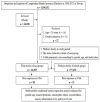Obese Patients Experience More Severe CSA than Non-Obese Patients
- PMID: 35162313
- PMCID: PMC8835470
- DOI: 10.3390/ijerph19031289
Obese Patients Experience More Severe CSA than Non-Obese Patients
Abstract
Objective: To investigate whether central sleep apnea (CSA) is associated with an increased risk of obesity.
Materials and methods: From 1 January 2000 to 31 December 2015, we screened 24,363 obese patients from the 2005 longitudinal health insurance database, which is part of the Taiwan National Health Insurance Research Database. From the same database, 97,452 non-obese patients were also screened out. Age, gender, and index dates were matched. Multiple logistic regression was used to analyze the previous exposure risk of obese and CSA patients. A p-value of <0.05 was considered significant.
Results: Obese patients were more likely to be exposed to CSA than non-obese patients would (AOR = 2.234, 95% CI = 1.483-4.380, p < 0.001). In addition, the closeness of the exposure time to the index time is positively correlated with the severity of obesity and has a dose-response effect (CSA exposure < 1 year, AOR = 2.386; CSA exposure ≥ 1 year and <5 years, AOR = 1.725; CSA exposure time ≥ 5 years, AOR = 1.422). The CSA exposure time of obese patients was 1.693 times that of non-obese patients. Longer exposure time is associated with more severe obesity and has a dose-response effect (CSA exposure < 1 year, AOR = 1.420; CSA exposure ≥ 1 year and <5 years, AOR = 2.240; CSA ≥ 5 years, AOR = 2.863).
Conclusions: In this case-control study, patients with CSA had a significantly increased risk of obesity. Long-term exposure to CSA and obesity is more likely and has a dose-response effect.
Keywords: National Health Insurance Research Database; case-control study; central sleep apnea; obesity.
Conflict of interest statement
The authors declare no conflict of interest.
Figures
Similar articles
-
Obese patients experience more severe OSA than non-obese patients.Medicine (Baltimore). 2022 Oct 14;101(41):e31039. doi: 10.1097/MD.0000000000031039. Medicine (Baltimore). 2022. PMID: 36253984 Free PMC article.
-
Chronic Obstructive Pulmonary Disease Effect of Nonapnea Sleep Disorder on the Risk of Obesity: A Nationwide Population-Based Case-Control Study.Int J Environ Res Public Health. 2022 Mar 30;19(7):4118. doi: 10.3390/ijerph19074118. Int J Environ Res Public Health. 2022. PMID: 35409801 Free PMC article.
-
Central sleep apnea in obese children with sleep-disordered breathing.Int J Obes (Lond). 2014 Jan;38(1):27-31. doi: 10.1038/ijo.2013.184. Epub 2013 Sep 19. Int J Obes (Lond). 2014. PMID: 24048143
-
Chronic opioid use and central sleep apnea: a review of the prevalence, mechanisms, and perioperative considerations.Anesth Analg. 2015 Jun;120(6):1273-85. doi: 10.1213/ANE.0000000000000672. Anesth Analg. 2015. PMID: 25988636 Review.
-
Central sleep apnea and Cheyne-Stokes respiration.Proc Am Thorac Soc. 2008 Feb 15;5(2):226-36. doi: 10.1513/pats.200708-129MG. Proc Am Thorac Soc. 2008. PMID: 18250216 Review.
References
-
- World Health Organization (W.H.O.) Obesity and Overweight. World Health Organization; Geneva, Switzerland: 2021. [(accessed on 20 October 2021)]. Available online: https://www.who.int/news-room/fact-sheets/detail/obesity-and-overweight.
-
- Kyrou I., Randevam H.S., Tsigos C., Kaltsas G., Weickert M.O. In: Clinical Problems Caused by Obesity. Feingold K.R., Anawalt B., Boyce A., Chrousos G., de Herder W.W., Dungan K., Grossman A., Hershman J.M., Hofland J., Kaltsas G., editors. MDText.com, Inc.; South Dartmouth, MA, USA: 2000. [(accessed on 25 October 2021)]. Available online: https://www.ncbi.nlm.nih.gov/books/NBK278973/
-
- National Health Service . Ministry of Health and Welfare. National Health Service; London, UK: 2020.
-
- Health Promotion Administration . Ministry of Health and Welfare. Taiwan ROC; Taipei, Taiwan: 2018. [(accessed on 23 November 2021)]. Available online: https://www.hpa.gov.tw/File/Attach/10042/File_12271.pdf.
Publication types
MeSH terms
LinkOut - more resources
Full Text Sources




